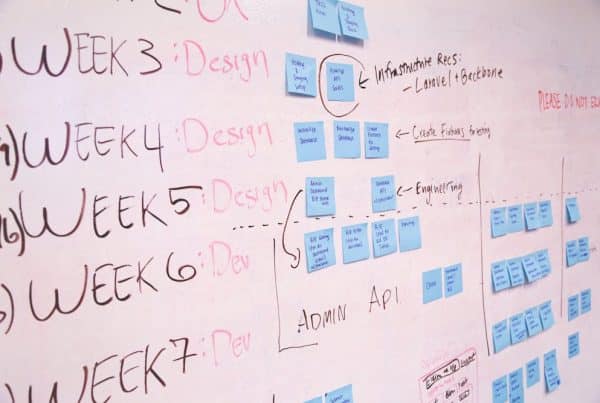Most clients think the cost of a website ends after the final invoice, but that’s just the beginning. How much does a website cost if the quote you get is rarely the full story?
Many of the hundreds of clients I’ve served over the last one and a half decades are surprised by ongoing expenses, such as hosting, security updates, and maintenance. How do you budget a website project?
This article breaks down hidden and recurring costs so you can better plan your website budget. We’ll go over all costs, from the initial quote to all the real-world long-term costs.
The Initial Quote: What’s Usually Included
1. Website Design
A website starts with an idea in your head and goals that you explain to a website design and development expert. The web designer will apply your ideas and goals to design mock-ups.
Mock-Ups
Mock-ups are a series of static images that display what your website will look like when it’s done. These mock-ups help you imagine how the different elements on the page work together, i.e., the:
- Layout.
- Color scheme.
- Navigation.
User Experience (UX) Design
UX design involves planning your website to ensure it’s easy to navigate and enjoyable to use. It focuses on creating a smooth and intuitive user experience for visitors. A good UX design involves the following:
- Deep research into your target audience.
- Creating a clear and organized website structure.
- Deploying effective visual hierarchy to guide users.
- Incorporating interactive elements to engage users.
User Interface (UI) Design
Designing a website’s user interface includes figuring out visual elements, such as:
- Buttons.
- Icons.
- Menus.
The idea is to create a pleasant user interface that complements the overall UX design.
UI requires:
- Consistency throughout the website.
- Appropriate colors, fonts, and visual hierarchy to enhance readability and brand consistency.
- Interactive elements for a more engaging interface.
2. Website Development
How long does it take to build a new website? It depends on many factors, but planning makes it faster and easier to be successful.
Web development typically starts with planning and design, then moves to back-end development (server-side scripting and database setup) and front-end (client-side) development.
Then, you need to create a database that the website will use to store and retrieve information from. Once these basics are in place, the actual development of the website and its design elements can begin.
Server-side Scripting
Server-side scripting entails creating dynamic sites with programming languages such as PHP, Python, or Java. The goal is for the site to interact with the server, i.e, retrieving data from a database or disbursing emails.
Developers in this stage consider issues such as security and compatibility when choosing a scripting language.
Client-side Scripting
Client-side scripting, which is done with languages like JavaScript, is responsible for making a website’s elements interactive. This scripting works by manipulating the page’s structure (created with HTML) and its visual presentation (defined by CSS).”
These scripts run on the user’s web browser, manipulating web page content without communicating with the server.
Form validation, image slideshows, and pop-up messages are examples of client-side scripting. During this stage, please consider:
- Browser compatibility.
- Performance impact on the user’s device.
- Security risks such as cross-site scripting (XSS).
Building Website Pages with Ideal Page Copy
You have to build the pages in your web design one by one. Start with the homepage, and work on the others in a logical order. Each page serves a specific purpose, so make your content useful and fun.
3. CMS Integration (WordPress, Shopify, etc.)
Most websites are built on WordPress and other CMS (Content Management System) platforms nowadays. These platforms offer user-friendly tools that enable non-technical users to develop and run website publishing.
Most CMS platforms like WordPress are built with server-side languages like PHP, but users interact through visual editors and admin dashboards without needing to code.
The Benefits of CMS Integration
- Easy content management enables quick updates and changes to the website.
- Design and layout consistency across all web pages.
- Built-in SEO features.
Popular CMS Platforms
- WordPress.
- Shopify.
- Drupal.
- Joomla.
4. Mobile Responsiveness and Light SEO Setup
The final factors affecting your initial website budget quote are mobile responsiveness and light SEO setup.
Mobile Responsiveness
Mobile responsiveness refers to the ability to adjust website or app layout and content to fit different smartphone and tablet screen sizes.
- This feature requires additional coding and testing to ensure a decent user experience across varying screen sizes.
- It also involves optimizing content, images, and navigation for a seamless mobile browsing experience.
Light SEO Setup
SEO refers to efforts dispensed to boost a website’s visibility on search engines like Google. A light SEO setup includes basic optimizations such as:
- Using appropriate keywords for page titles.
- Embedding alt text to images for better accessibility and indexing.
- Creating a sitemap for easier crawling by search engines.
- Making your web pages load faster to better user experience.
The Hidden & Ongoing Costs You Should Expect
Let’s break this section into smaller digestible sub-sections.
1. Domain Registration
A domain registration fee is an annual cost that allows you to obtain and use a custom domain name for your website. This cost ranges from $10–$20 per year, depending on the registrar and the type of extension (.com, .net, etc.) you choose.
You may find the domain name you want, aligning with focus keywords or your brand name, is already taken. In this case, you may need to purchase the domain from its current owner at a higher cost.
Some premium domain names cost thousands of dollars, making it a significant investment for your website. However, a unique and memorable domain name helps with brand recognition and winning organic traffic.
Remember, you have to pay annually for your domain name or risk losing it to someone else. Keep track of your domain name expiration date and renew it promptly to avoid any disruptions in your online presence.
2. Hosting Services
Next, you’ll need a hosting service to store and manage your website files. Hosting services provide you with server space to store your website’s data and make it accessible online.
The Various Types of Hosting Services
- Shared hosting.
- VPS (Virtual Private Server) hosting.
- Dedicated server hosting.
- Cloud-based hosting.
Each type has its advantages and disadvantages in terms of cost and performance. Research and choose the best option for your website’s needs.
Factors That Affect Monthly Hosting Prices
- Storage space.
- Bandwidth.
- Security features.
- Customer support.
- Uptime guarantees.
- Scalability options.
Select a hosting plan that enables easy scaling. That way, you can start small with affordable hosting packages and scale up as your audience and business grows.
3. Website Maintenance
What’s my idea of a perfect website maintenance package?
Core Updates (WordPress/Plugins/Themes)
Whether custom-built or using a CMS like WordPress, websites require regular updates to their core software, plugins, and themes. Updates embed debugged scripts so your website runs smoothly and securely.
Remember the script we discussed earlier? One of the primary reasons for having a backup is to protect the core update processes. If the update process breaks something in your code, you can easily restore the website to a previous version.
Bug Fixes and Troubleshooting
You also need to frequently check for bugs and fix them. Bugs can arise from coding errors, conflicts with different plugins or themes, or server environment changes.
Troubleshooting is necessary when something isn’t functioning properly on your website, such as a broken link or an error message.
Luckily, most CMS platforms have active communities and support forums where you can find solutions to common bugs and troubleshoot issues. You can also hire a developer if you’re not comfortable tackling these tasks yourself.
Performance Optimization
As you continue populating your site with posts and content, your users are also increasing in number. You should regularly check your web performance and optimize it as needed.
Optimizing involves efforts to improve its loading speed, responsiveness, and interactivity.
Some tips for optimizing your website’s performance include:
- Compress images to reduce their file size.
- Subscribe to a reputable content delivery network (CDN) to reduce the load on your server.
- Add lazy loading so visual elements only load when a user scrolls to them.
- Utilize caching techniques to minimize the number of database calls and enhance page loading speed.
- Regularly test your website’s performance using tools like Google PageSpeed Insights or GTmetrix.
- Minimize HTTP requests by optimizing code for faster execution.
4. Security Services
Initial and Renewal Fees for SSL Certificates
You need SSL certificates to encrypt all information transmitted between the two parties, preventing potential hackers from intercepting.
The initial SSL cost varies depending on the type and level of validation required.
Firewalls, Malware Scans, and Backups
You need firewalls to barricade your website from potential threats, blocking unauthorized access and filtering out malicious traffic.
Malware scanning is the process of checking for any harmful code or software on your website. You should do it regularly to ensure that your website is not compromised.
Backups are copies of your website’s data that you can rely on to restore your site in case of data loss or cyberattacks. It’s essential to have regular backups to safeguard your website’s information.
Premium Security Services
This option is for websites that handle sensitive user data in large quantities, such as e-commerce websites or financial institutions. Premium security services offer a range of advanced features for countering cyber threats.
These services often include:
- Advanced malware scanning and removal.
- Real-time threat detection.
- Vulnerability assessments.
- DDoS protection.
They may also provide expert support for website security, including regular audits and updates to establish the latest security measures.
5. Content Updates & Management
New Page Additions or Blog Posts
As you grow. introducing new products and categories, you may need to add new pages to your websites. You’d need page copy as well as some web design and dev work to build out new pages.
Websites should publish new content to keep audiences engaged and boost SEO. Publish blog posts, guides, and articles to keep your audience informed, engaged, and in awe.
Content Editing and Media Uploads
Content editing is an ongoing task that requires proofreading, formatting, and updating existing content. You also need to frequently check for broken links, outdated information, and grammatical and spelling errors.
You don’t want to risk losing credibility with your audience by having outdated or incorrect information on your website.
6. SEO & Analytics
Ongoing Keyword Optimization
Relevance is a big part of web publishing. Therefore, identify the most popular keywords and phrases commonly used among your target audience online.
Use keyword tools and analytics to track popular search terms and use them to make helpful content.
Analytics Tracking
Intuition is easier to get with analytic tools that help to assess your web performance by tracking metrics such as:
- Page views.
- Bounce rate.
- Average time on page.
This information can help you refine your content and web design to meet your audience’s needs better.
How Much Does It Cost to Build a Website?
It all depends on your goals, priorities, and budget. If you skimp on the design budget, you end up asking how much it costs to redesign a website.
Follow these tips for creating a successful small business website to score a cost-effective balance between UX, functionality, and cost.




